Balletic skateboarders and spectacular surfers look here to stay - as 3x3 basketball makes big noise in empty venue
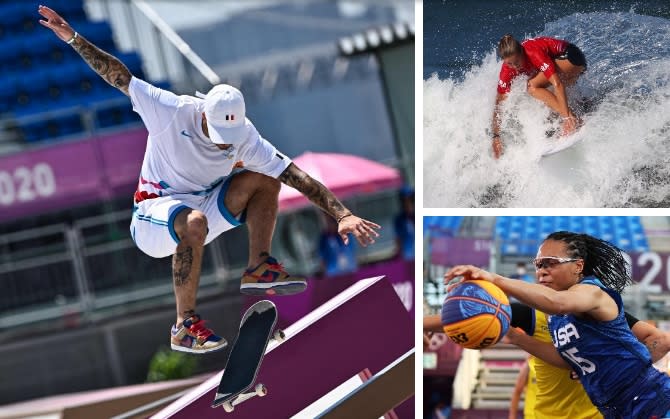
Three new sports have been added to the Olympic roster in Tokyo: 3x3 basketball, skateboarding and surfing.
The decision on which sports were to be uploaded to the programme was made five years ago. As usual, the lobbying on behalf of squash, darts and snooker came to nought.
The reason why they failed and the newbies caught the sporting bureaucrats’ eye is pretty simple: they are activities which do not appeal to the right demographic. Because the International Olympic Committee is not interested in expanding its Games for social or health reasons, or even to make the fortnight a bit more interesting.
It is doing so in order to reach new markets, new commercial opportunities, to open up different revenue streams. What they value is not sporting relevance, meaning or heritage. It’s money.
But, however cynical or opportunistic their inclusion, the fact is, as sporting events, you don’t know what the three newbies are like until you have watched them.
3x3 basketball
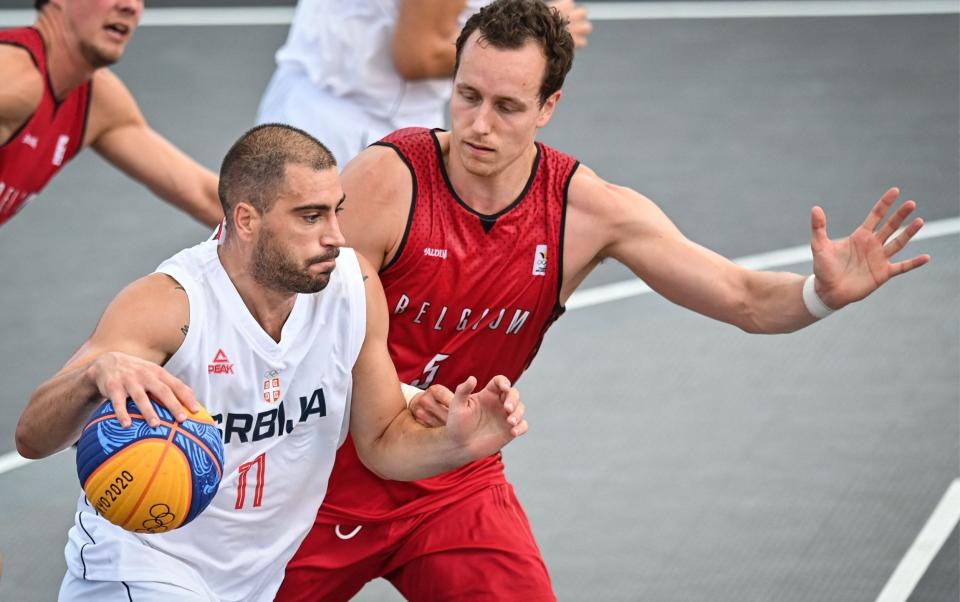
In the Aomi Urban Sports Park the new face of the Olympics is on show. This is where the Games are getting down with the kids, opening themselves to a new, younger demographic.
There is a clue in the name. This is urban as in a shorthand for cool. Though, in truth, the Aomi Urban Sports Park is about as urban as Waitrose in West Byfleet. A smart, temporary arena has been constructed in the middle of an exhibition space usually given over to promoting the latest products from the Japanese motor industry.
It has been transformed, apparently, into the centre for the hip new Games. Which is an interesting departure from an organisation whose executives have in the past only thought about things hip when planning when they might book themselves a surgical replacement.
It is here that two of the new disciplines introduced in Tokyo are being showcased: sport climbing and, the first to take the stage, 3x3 basketball. As the name might suggest, this is a foreshortened version of the game involving three players per side and just the one hoop, into which both teams try to put the ball.
Fast, simple to understand and requiring no greater concentration span than that displayed by a particularly dopey goldfish, it is a version of the game familiar in any US city, where it is played on a street court behind a fence. Since it became internationally codified in 2007, 3x3 has speedily come to be recognised as the most-played urban team sport in the world. Which is why the Olympics have latched on to it.

They want some of the market it brings, particularly the commercial partners keen on flogging things to those not particularly energised by the traditional Olympic offering. What is going on at the Aomi Urban arena is not so much a sporting event as an urgent campaign for demographic relevance.
And, because those targeting things at the young assume this is what the young want, it is very noisy in the way it is presented. A DJ spins incessant rap music, a match commentator booms across the public address system, yelling, in a cod American accent, such acute insights as “good job” when a basket is scored.
This, though, is where the problem lies, a problem you suspect that is going to infect the entire Tokyo Games, whether the sports involved are urban, suburban or decidedly rural. Without a crowd such insistent presentation falls woefully flat. Chivvying empty stands is a fruitless activity. Not that it stopped our man in the Urban Sports Park.
“Give it up,” he bellowed as one of the competing teams lined up ahead of their pool game, “for the People’s Republic of China.”
Since the audience consisted of a few dozen media, fellow protagonists and an American press photographer decked out in full paramilitary camouflage like he had just returned from storming the Capitol, there was not much giving up being done.
This was the biggest stage this sport has ever played and the steepling stands were completely empty, save for several busy volunteers carefully – and somewhat pointlessly – disinfecting the seats between each game.
Even when Jill Biden turned up to watch the American women’s team beat France, it would be hard to describe the stadium as having anything approaching an atmosphere. The Barbadian journalist, clearly still hamstrung by jet lag, who dozed through the entirety of the game between Latvia and Poland rather set the tone.
Yet, even in such extremis, it was possible to imagine that a crowd would have taken to this. As contrived new sporting iterations go, it was on another level to The Hundred.
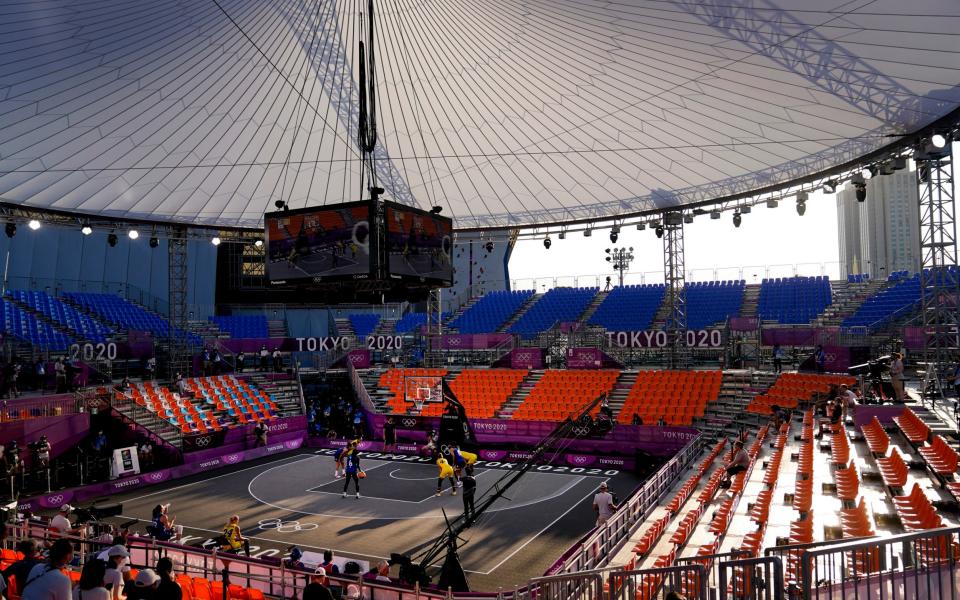
Quick, skilful and – particularly when the Serbians played – full of guile, wile and bile, it is an undeniably fun watch. And this despite the incessant bawling interventions from our match commentator that made a dentist’s drill sound comforting in comparison. In truth the real sadness was that nobody was there to appreciate the proselytising efforts of the players, as they gamely tried to engage a new audience.
“This is a sport that needs a crowd,” Dusan Bulut told me after his Serbian side had easily out-foxed the statuesque representatives of the People’s Republic of China. “So yes, it is a shame that we have no one here. But, still, we have been playing all our lives and nobody expected to see this day. This is a sport that has literally gone from the streets to the Olympics. The future is amazing for this sport.”
Dusan, a full-time professional for a club in the UAE and reckoned the best player in the world, is a fine ambassador for its attributes. Quick, lithe and with a deft sleight of hand, he is a delight to watch. If only someone had been, I told him. He smiled wanly.
But then, soon after he had completed his match, came evidence that, despite the vacant stands, there were plenty viewing him in action after all. Because a figure was projected on to the screen above the court: 17,528,927.
This, the self-congratulatory commentator informed us, was the size of the television audience tuning in to watch at that precise moment. Never mind how on earth that number was arrived at, it was the one that counts for the IOC.
Barely anyone was watching it in the flesh, but this was a sport apparently reaching many of the people they want to sell to. And for the IOC that is what matters.
Skateboarding
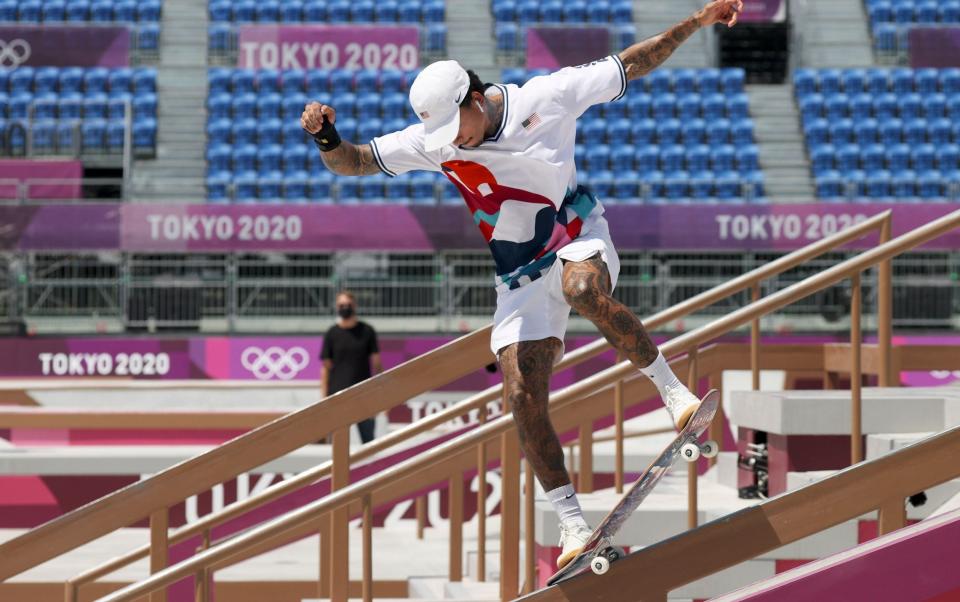
There is a long list of Covid protocols in place for those few allowed to watch events in Tokyo. The signs are everywhere: don’t chant, don’t cheer, don’t clap and for goodness sake don’t hug anyone.
It is safe to say the moment Yuto Horigome was confirmed as the first ever Olympic men’s street skateboarding champion, no one was alert to such restrictions. To a man, woman and all points in between, all of the local volunteers, journalists and officials were jumping around in unfettered delight.
You could only imagine the noise if the sizeable temporary stands at the Ariake skateboarding park had been full. This was the point the Olympics took off.
Horigome is the hometown hero, who first skated as a boy just eight miles from the place he won gold. His picture adorns a significant percentage of the billboards in the city, every local magazine has him on its cover, he is the one they wanted most of all to win. He is, in short, the Jessica Ennis Hill of the Tokyo Games.
And to make things even more delightful for the locals, Horigome won his gold with panache, verve, not to mention, if it does not seem excessive to use such a word to describe a bloke riding a plank of wood down a flight of concrete steps, elegance.
His win did something else too: it cemented skateboarding’s place on the Olympic roster. Watching him in action was to see a true sporting master.
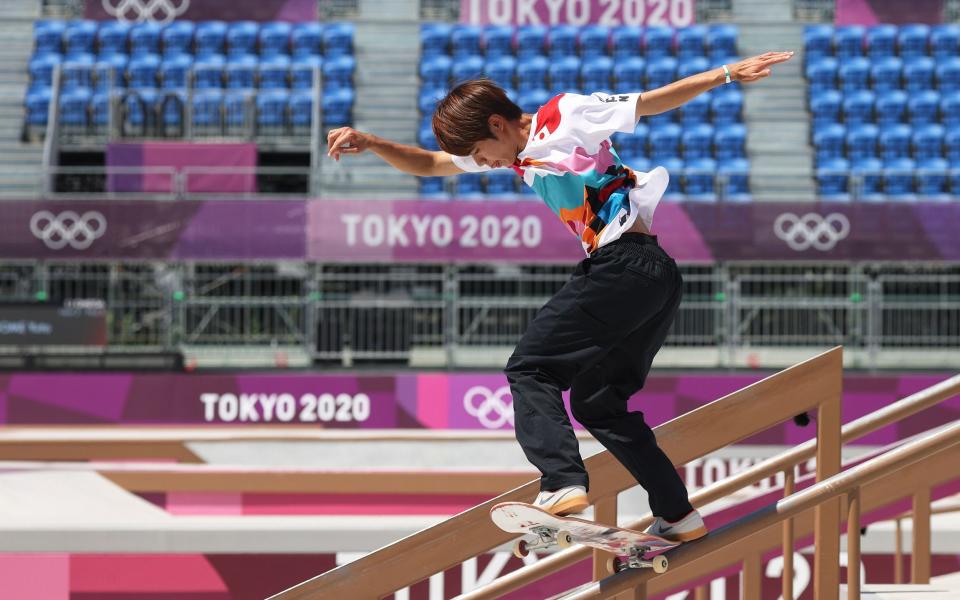
For the uninitiated, there was a pleasing informality about the whole process of Horigome arriving atop the podium. This was a sporting event in which nobody wore team kit, there were no pyrotechnics or contrived introductions, and in which every competitor appeared in danger of their phone dropping out of their pocket as they went about their business.
Phones seem to be central to the sport. All the riders were wearing ear bugs, not to communicate with their coach, but to listen to music.
When they had completed a round, you could see many of them immediately reaching for their phone to pick a track for their next go. Jagger Eaton, the American who came third, celebrated his moment by taking out his camera and filming Horigome being mobbed by the local media.
From this it is clear skateboarding likes to think of itself as a different kind of sport. Not least because the whole point of street skateboarding is to do it anywhere other than a place designated for skateboarding. This is a sport born in defiance of rule or regulation. But here were judges and timings and leaderboards.
Here too were urban features – the flights of steps, the handrails, the concrete obstructions – grafted on to a purpose-built track. It was a bit like the added buttresses on a fives court, there to mimic the architecture of the informal sporting terrain where the game was invented.
The point of the obstacles is to test and challenge the competitor’s application, to allow them to show their mastery of their board. Though, frankly, unless they fell over, for those of us new to the sport it was difficult to assess whether what they did was close to perfect or merely adequate.
This is a sport that requires a lot of value judgement. Watch skateboarders on any city street, and much of the time they are standing around nodding in appreciation of their fellow boarders’ efforts.
Knowing nothing about what constitutes a good performance, I positioned myself next to two American television commentators. It was like intruding on that dog judging scene from the movie Best in Show; in a thrilling display of one-upmanship, the pair of them took it in turns to demonstrate that they knew more about the sport than the other one.
“You’d expect Nyjah to make that trick, he usually nails it,” said one after the American Nyjah Huston fell after trying to rotate his board coming down a vertiginous hand rail.
“Well you say that, but he should be raising the stakes here by trying something like a 360 Cab,” trumped the other.
If you are wondering, a 360 Cab is a fakie backside Ollie, first perfected by the American skateboarder Steve Caballero in 1981. So now you know.
This may be a sport drenched in exclusive jargon, of lip-slide nosegrinds, goofy stances and kick-flip back-lifts, but it is also a sport of balletic precision. These are proper athletes, gifted with a gymnast’s balance. The control they exercise over their board is extraordinary.
In many ways it is a sport best viewed in slo-mo on the giant screen abutting the course. On that you could see how, with just a flick of the foot, they could rotate the board as they leaped over an obstacle, before reconnecting with it and rolling away in perfect harmony.
Well, some of them did that. Others less so. In one preliminary round, Matt Burger of Canada fell on every attempt, his Olympics ending in a view of the Tokyo sky as he lay time and again flat on his back on the concrete.
The format is simple: each competitor was obliged to undertake two rounds of the circuit, performing as many tricks as they could muster over its handrails and flights of steps in 45 seconds. Then they had five attempts to pull off a single trick over one of the features. The best four of their seven attempts were scored.
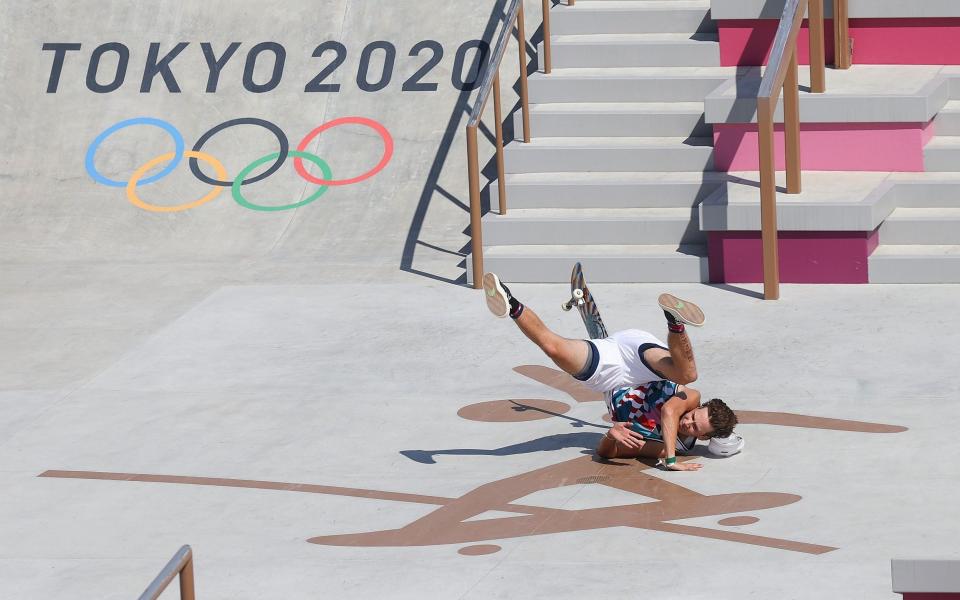
To the untutored eye – and boy was this eye untutored – there was something counterintuitive about the approach to an obstacle: namely, the quicker you went at it the more likely you were to remain on the board. Horigome was particularly adept at doing everything at warp speed.
The pre-event favourite was the heavily tattooed Huston, the world’s richest boarder. With a list of sponsors longer than the Greek national anthem, he is the financial success story to which everyone else in the sport aspires.
But in the end Huston had a problem, falling several times in the final and finishing well down the field. Horigome, by contrast, was consistently majestic, apparently floating above his board.
Even for the clueless there could be no question he was the winner. And no question, more to the point, that he did it in style.
Surfing
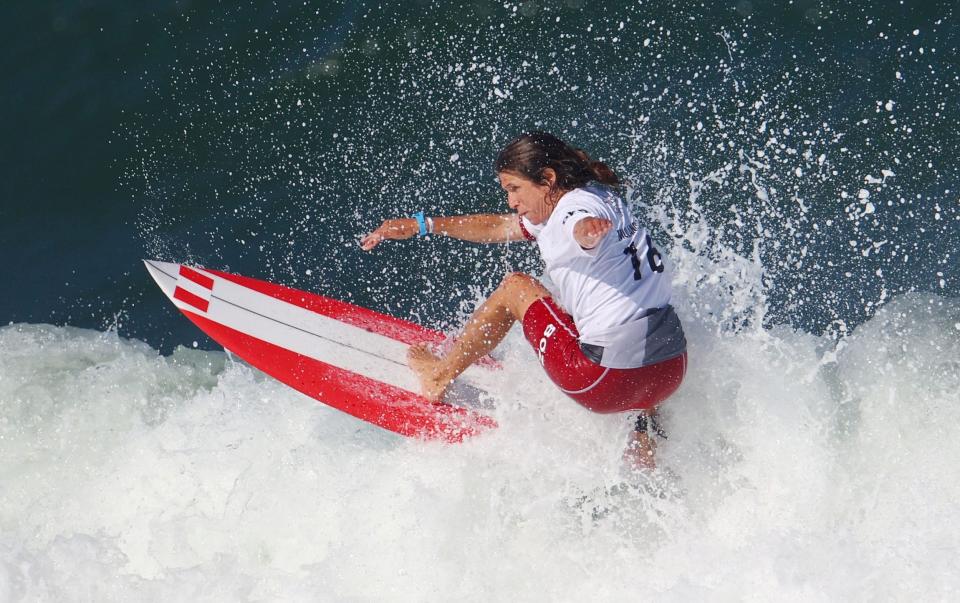
As anyone who has ever entered the sea in the attempt to catch a wave will know, surfing is entirely dependent on the weather. If there are no waves, then there is no action. Simple as that.
Never mind that this is a sport making its debut in the Olympics, never mind that the world was watching, it could only go ahead when the waves were of sufficient scale to offer appropriate challenge. So, after a long Saturday spent hanging around staring into the middle distance hoping something approaching a breaker might appear on the horizon, on Sunday, as a typhoon neared the Japanese coast, it was action stations.
At the Tsurigaski surfing beach a couple of hundred kilometres from Tokyo, boards were being waxed down, tactics readied and sunblock applied to noses. Suddenly, after sitting around all the previous day, everyone had to be ready to go, starting at 7am.
So it was that in a packed day, most of the preliminary rounds in both the mens and women’s competitions were conducted. It works like this: six competitors, each wearing a different brightly coloured shirt, the easier to be identified from the shore, paddle out into the incoming tide.
They then have half an hour to catch as many waves as they can. With each one they catch, they are judged on how they ride it: things like the degree of difficulty, how many manoeuvres they fit in and the variety of their moves. Their best two ride scores are combined to give a final total.
When a particularly good wave comes in, several competitors can go at once, all up on the wave, weaving and bobbing like they are starring in a 1970s aftershave commercial. The best ride with aplomb and skill, skimming across the water.
It is inspiring to watch, as tiny human figures attempt to corral the power of nature. Though it’s captivating, in truth it is a sport far better observed on television. Attempting to follow what is going on down at the beach, where you are so far away from the action it might as well be taking place in Korea, can be no easy task.

But then that is what the IOC wants from its fresh Olympic sports: things that look good on the box. And, sadly for traditionalists, surfing looks better than full bore rifle shooting.
The highlights reel that played at the end of the day’s competition, of hectic spins and vertiginous leaps, was spectacular. As was the footage of calamitous crashes. Watching someone end up face down in the surf, detached from their surfboard, disappeared beneath the broiling brine, provides a moment of drama all too often absent from a day at the archery.
How much sporting jeopardy is involved, however, is less obvious. From each of the rounds the top three of five competitors advanced. A bit like the group stage of the Euros, then, it was harder to be knocked out than to advance. Though that didn’t stop the celebrations at making it through.
At the end of the women’s competition second round, for instance, the winner Yolanda Hopkins of Portugal was given a Covid-busting bear hug by her coach. This was as nothing, however, compared to Sofia Mulanovich of Peru who discovered she had made it to the next stage only when she had left the water and seen on the scoreboard that her final ride had advanced her up the standings into the qualification places.
Her celebration was magnificent. Now she is through to the next round. Though she might have to wait: quite when that will be is somewhat dependent on the weather forecast.


